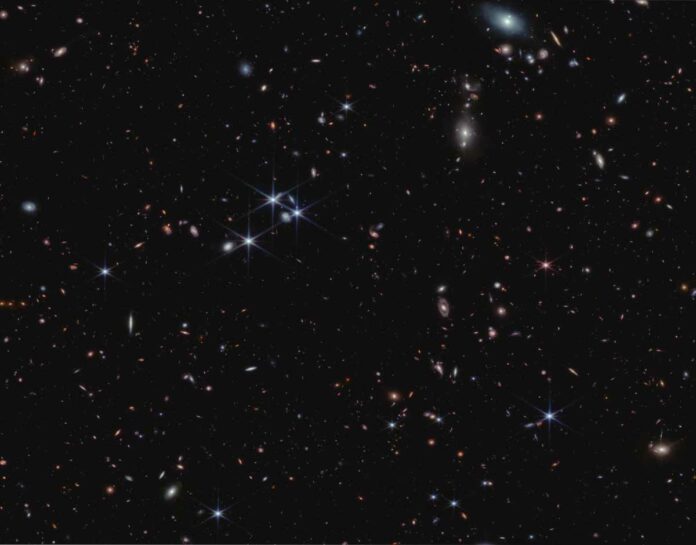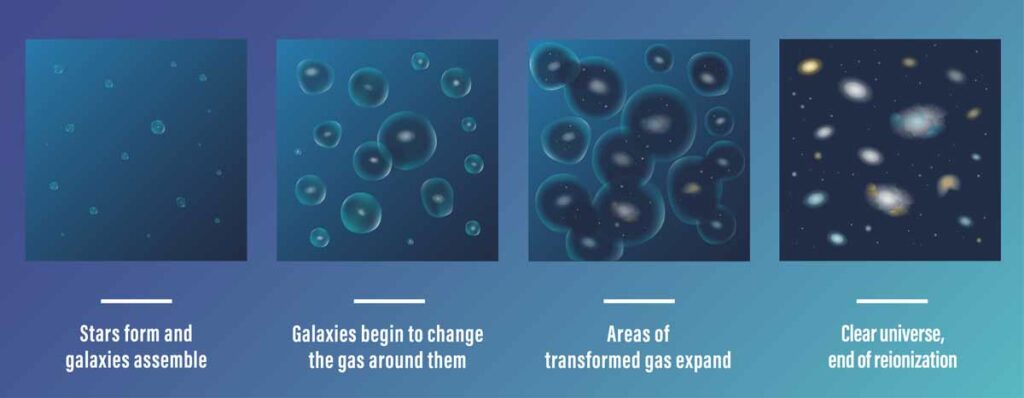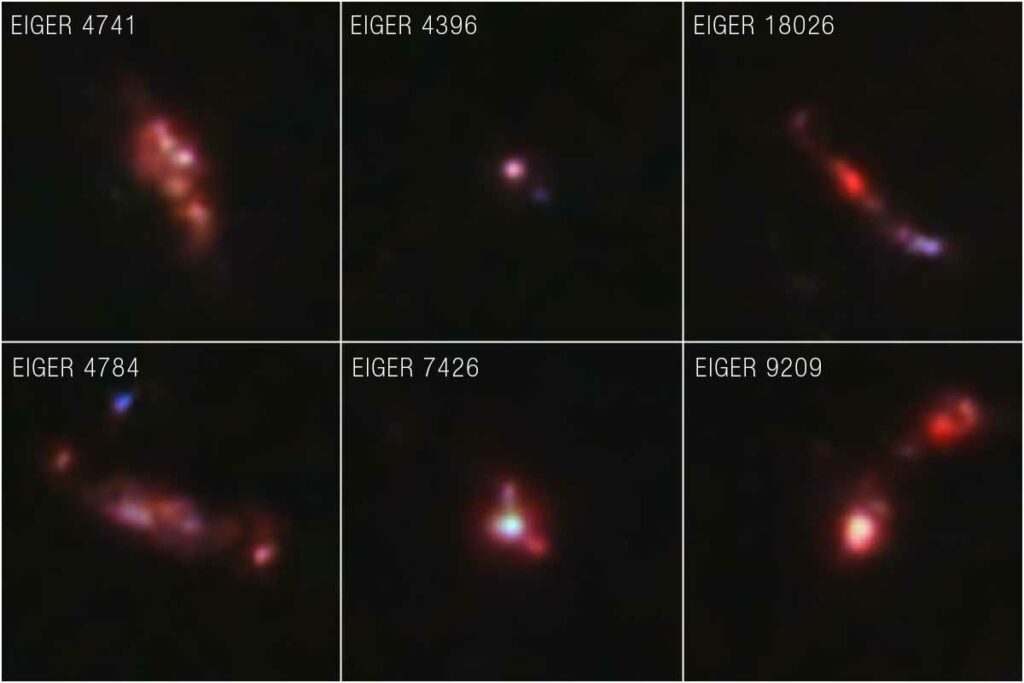New findings from NASA’s James Webb Space Telescope shed light on the remarkable transformation of the early universe, revealing the pivotal role played by galaxies in shaping its evolution. In an era known as the Era of Reionization, approximately 1 billion years after the big bang, the gas that filled the cosmos underwent a profound change. Initially opaque, it gradually became transparent, allowing starlight to penetrate and illuminate the vast expanses of space. Researchers led by Simon Lilly of ETH Zürich in Switzerland, utilizing data from the Webb telescope, have now uncovered the underlying mechanism responsible for this cosmic transition.
A Universe in Transition
During the early stages of the universe, gas between stars and galaxies was impenetrable, preventing the passage of energetic starlight. However, over hundreds of millions of years, the situation changed dramatically. The gas surrounding galaxies became transparent, allowing light to pass through. This breakthrough discovery, made possible by the James Webb Space Telescope, demonstrates that the emission of light from galaxies’ stars played a vital role in heating and ionizing the gas, eventually clearing the cosmic view for observers.
Unlocking the Secrets of Reionization
For years, scientists have been striving to unravel the mysteries of the Era of Reionization and gain definitive evidence to explain the transformative processes that occurred during that time. With the latest data from the Webb telescope, researchers have successfully unveiled the long-awaited answers. By analyzing the transparency of the gas surrounding galaxies, the team has not only confirmed that these transparent regions exist but has also measured their sizes. Daichi Kashino of Nagoya University in Japan, the lead author of the research, explains, “With Webb’s data, we are seeing galaxies reionize the gas around them.”
Galaxies as Pioneers of Reionization
The newly discovered transparent regions of gas are incredibly vast compared to the galaxies themselves. Using an analogy, one can imagine a hot air balloon with a small pea suspended inside – that is the scale of these galaxies in relation to the cleared gas regions. The data collected by the Webb telescope reveals that these relatively diminutive galaxies were the driving force behind the reionization process, gradually clearing and expanding massive sections of space surrounding them. As time passed, these transparent “bubbles” continued to grow and eventually merged, leading to the complete transparency of the entire universe.
Webb’s Targeted Observation
To gather this groundbreaking evidence, Simon Lilly’s team deliberately aimed the Webb telescope towards a quasar, an extremely luminous supermassive black hole acting as a cosmic flashlight. By observing the gas between the quasar and the telescopes on Earth, the researchers could determine whether the light traveled through opaque or transparent regions. This meticulous approach allowed the team to combine the Webb’s data with observations from other observatories, including the W. M. Keck Observatory, the European Southern Observatory’s Very Large Telescope, and the Magellan Telescope. Anna-Christina Eilers of MIT, the lead author of another paper, explains, “By illuminating gas along our line of sight, the quasar gives us extensive information about the composition and state of the gas.”
Galaxies’ Last Stand
Webb’s observations have enabled researchers to identify galaxies near the line of sight of the quasar, providing conclusive evidence of their role in clearing the surrounding space at the end of the Era of Reionization. The team’s analysis indicates that these galaxies have created transparent regions spanning approximately 2 million light-years in radius. To put this in perspective, this distance is equivalent to the space between our Milky Way galaxy and its closest neighbor, Andromeda. The newfound clarity regarding the cause of reionization is a significant milestone, as it resolves longstanding uncertainty among scientists.
A Glimpse into Galactic Chaos
Upon further examination of the data gathered by the Webb telescope, fascinating characteristics of these galaxies have emerged. Jorryt Matthee, a researcher from ETH Zürich, highlights their distinctive nature when compared to galaxies in the present-day universe. Matthee explains, “The Webb telescope reveals that these galaxies exhibited a higher level of chaos. They were actively engaged in the formation of new stars and likely experienced numerous supernova events. Their cosmic journey was undeniably eventful!” Moreover, the telescope’s exquisite imagery has provided confirmation that the central black hole within the observed quasar holds the title of being the most massive known in the early universe, boasting a staggering mass 10 billion times that of our Sun. This revelation serves to deepen the enigma surrounding the early development of quasars.
Unveiling the Universe’s Secrets
Buoyed by the overwhelming clarity of the results obtained from the first field of observation, Simon Lilly’s team, known as the Emission-line galaxies and Intergalactic Gas in the Epoch of Reionization (EIGER), is preparing to explore galaxies in five additional fields. Webb’s capabilities, especially its near-infrared camera (NIRCam) and wide-field slitless spectroscopy mode, have allowed the team to employ a “spectacular spectroscopic redshift machine,” as they describe it, enabling extensive characterization of celestial objects.
The team’s initial findings will be published in The Astrophysical Journal on June 12
- “EIGER I. a large sample of [O iii]-emitting galaxies at 5.3 < z < 6.9 and direct evidence for local reionization by galaxies,” led by Kashino
- “EIGER II. first spectroscopic characterisation of the young stars and ionised gas associated with strong Hβ and [OIII] line-emission in galaxies at z = 5 – 7 with JWST,” led by Matthee
- “EIGER III. JWST/NIRCam observations of the ultra-luminous high-redshift quasar J0100+2802,” led by Eilers
As the mysteries of the early universe gradually unfold, the James Webb Space Telescope stands as an indispensable tool, shedding light on the cosmic processes that have shaped our existence and pushing the boundaries of human knowledge.



